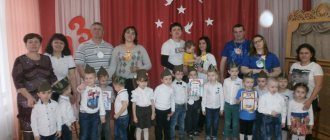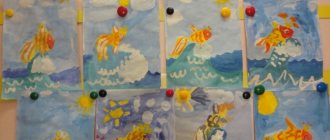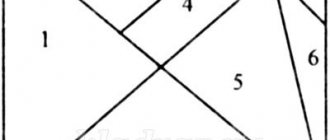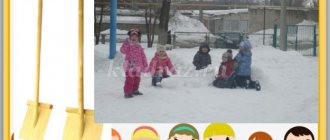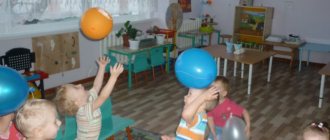Table: card index of topics on labor activity in the senior group of preschool educational institutions
| Author | Savina P.I. | |||
| Type of labor | Subject | Tasks | Examples of work | Note |
| Household labor | "Cleaning up closets and shelves" |
| Try to encourage your children to clear out bookshelves or organize toy cabinets. | Tell the kids a story about slobs and explain that they shouldn’t do that. |
| "Neatly made beds" |
| After quiet time, talk to your children about the importance of keeping their bed tidy. Explain to them in a playful or fairy-tale way about the germs that can appear in the bed if it is not made. | You can cut out figures of microbes from cardboard and place them on the bed of a child who has not made it. | |
| Labor in nature | "Water the plants" |
| Invite the children to take care of the indoor flowers that are in the group. If there are no such flowers, then you can take the children outside and talk about watering plants using the example of street bushes, grass or flower beds. | You can imagine the watering can as a “cloud”. Thanks to this, you will not only show children the principle of working with plants, but also explain what rain is. |
| “Wet wiping of leaves of large-leaved plants” |
| Teach children about the dust that flies in the air and settles on plants. Explain to them how to carefully wipe the leaves. | Try using not only rags, but also damp sponges. They absorb liquid much better and stay wet. They are then easy to dry. | |
| Teamwork | “General work on the corner” | Learn to create collective crafts and figurines to decorate their “children’s corner.” | Use several types of creative materials: paints, pencils, plasticine, cardboard, etc. The main task of the teacher, in addition to instructing and explaining to children how to work, is to control all actions with dangerous tools. | Encourage children to paint with their fingers. You can help color their hands and put them on paper. |
| "Joint and general games" |
| Try playing the group game “Tea-Tea to the Rescue.” The player who will be the “driver” is selected. He runs after other guys and catches them. The child he touches becomes “bewitched.” Another player can touch the “bewitched” and free him. The game ends when all players become "bewitched". | Playing games with sports equipment such as balls or jump ropes is useful not only in terms of developing social skills, but also improves physical abilities. | |
| Self-service | “Independent search for answers to the question posed” |
| Ask your child a question like: “What was the name of the chicken that laid the egg?” Ask your child to find the answer in the story itself. This will prepare him well for future assignments at school. | Question options: “Where is Koshchei’s life hidden?”, “How many knights come out of the sea in Pushkin’s fairy tale?”, “Who is the mermaid?” |
| "Self-care" |
| Provide your child with a clothes brush and talk about how to properly clean clothes. Explain why this should be done (“to look neat”). | Try talking about how to keep your clothes in order so that you have to clean them as little as possible. | |
| Duty | "Duty in the dining room" |
| Select a few children and bring them to the dining room. Then tell them how to set the table and arrange the plates. After this, you can begin practical work and allow the children to do everything on their own. | Try to come up with some little incentives for those guys who were on duty especially well. |
| "Street duty" |
| Give a few kids brooms and offer to sweep the leaves off the paths if it's autumn. In winter, you can ask for help removing small piles of snow using shovels. And in the spring you can show the children how to water the flowers in the flower beds. | Always make sure that your child is assigned only work that he is definitely able to do. | |
| Handmade and artistic work | "Creating Crafts" |
| Try to gather a small group of children and make a plasticine craft with them. For example, the “Hedgehog” craft:
| This type of work allows the teacher to get to know the children better. |
| "Artwork" |
| Give children coloring books and provide pencils. | Try showing your children a few drawings that you can draw yourself. | |
Abstract of GCD in the senior group on labor education
Abstract of educational activities for children 5-6 years old “Helpers”
Purpose: to clarify and generalize children’s ideas about work and professions. Objectives: • To consolidate children's knowledge about various professions. • Expand and activate vocabulary on this topic. • Develop speech, thinking, activity, independence. • Develop the ability to finish what you start. • Teach children basic work actions. • Foster respect for working people. Integration: Cognitive development, speech development. Equipment and materials: pictures with professions (cook, tailor, teacher, builder, doctor, hairdresser);
pictures of answers to riddles (needle, knife, book, crane, thermometer, mirror); ball. Basins with water, napkins, towels, aprons for each child. Preliminary work: looking at pictures, talking about parents’ professions, reading fiction, board and didactic games on this topic. Progress of the activity
Children stand in a circle and greet each other: Hello golden sun, Hello blue sky, Hello you, hello me, Hello all my friends! Children sit on chairs. The teacher reads a poem: There are many different professions, Photographer, cook and teacher, Driver, janitor and builder, And we can’t count them all. It doesn’t really matter who we are, because the main thing is to love your work! - What is this poem about? (children's answers) - What is a profession? (children's answers) - A profession is something that is done every day and that is useful for other people. The profession needs special training, and it is important that the person likes it and likes it. —What would you like to become when you grow up? (children's answers) - Now let's check how well you know the professions. Word game “Think, guess, find.” (There are pictures of professions on the board. The teacher makes riddles about objects of labor, the children guess and name the profession, who needs this tool, the object of labor for work, and the answer-picture is attached next to it). 1. I am short, thin and sharp. I look for a path for myself with my nose, I drag my tail behind me. (needle and thread) 2. There is a magic glass. It reflects everything. (mirror) 3. I am very sharp and steely. I will help you cut the bread. But be careful with me. I can cut your finger. (knife) 4. Not a tree, but with leaves. Not a shirt, but sewn. Not a person, but a storyteller. (book) 5. With my long neck I will turn the heavy load. Where they order, I will put it, I will help a person. (crane) 6. I’ll sit under your arm, 7. And I’ll show you what to do. Or I’ll put you to bed, Or I’ll let you go for a walk. (thermometer) - Well done, you solved all the riddles correctly. Now everyone stand in a circle and say who is doing what. Word game "What does it do?" (the teacher throws the ball and asks what the cook is doing - the child finishes the sentence - preparing food). Builder, milkmaid, teacher, driver, fireman, hairdresser, postman, tractor driver, pilot, doctor, artist, seamstress, baker, photographer, janitor, teacher (the last one to name the teacher). - Who else helps the teacher in the group? (children's answers). What does she do, what work does she do? (children's answers) - She has a lot of work: cleaning the group, washing the floors, setting the tables, and helping you get dressed. Maybe we can help her today too. (children's answer). Let's put things in order in the doll's corner, wipe off the dust, and wash the chairs. - To do this, we will divide into three teams: children take pictures: those with furniture - wash chairs, those with toys - wipe the dust on the shelves and toys; whoever has the dishes, wash the dishes and dust the cupboard. Agree on who will take out and put away the toys, who will wipe the dust, who will wash the toys, who will wipe them dry and put them back in their place. The team that gets the job done faster can help other guys. — What do you need for work? (children's answers) Put on aprons, take napkins, bowls of water and get to work. After finishing work, invite a nanny. She thanks the children for their help. — You liked working and helping your elders. Was it difficult? (children's answers) - And people say: “Time for business, time for fun.” What does it mean? (children's answers) Yes, we've worked, now we can relax. Thank you.
We recommend watching:
Summary of educational activities in the senior group “Northern Adventures” Card file of games on labor education for preschoolers Parent meeting - entertainment in the preparatory group for school Summary of a lesson on labor education in kindergarten
Similar articles:
Training children of the younger group in labor activities
Summary of a mathematics lesson in the senior group of kindergarten. Geometric figures
Diagnostics of the results of labor activity in the senior group of preschool educational institutions
The diagnostic card helps the teacher evaluate the results of working with children and sum up the results for the six months. In addition, with the help of this document, the teacher systematizes information and determines what each child has achieved and what he cannot cope with.
The diagnostic card records all types of work activities of senior group students.
Table: example of a diagnostic card
| Author | Savina P.I. | ||
| Development indicators | Actions and tasks | Positive result (the child copes with the task) | Negative result (child fails to complete the task) |
| Motivation | Have a desire to participate in work activities | ||
| Gain the skill of taking a proactive approach to business | |||
| Views of adults' work | Desire to provide all possible assistance to adults | ||
| Attitude to work | Desire to learn about future professions | ||
| Respect for other people's work | |||
| Careful attitude towards the results of your work | |||
| The working process | Careful handling of materials | ||
| Use the most productive work methods | |||
| Finish what you started | |||
| Teamwork | Friendliness and ability to work in a team | ||
| Develop communication skills | |||
| Mandatory | Competently evaluate the results of work | ||
| Have the habit of taking orders responsibly | |||
| Labor in nature | Appreciate and respect nature and its gifts | ||
| Have basic plant care skills | |||
| Know how to plant seeds | |||
| Self-service | Be able to take care of your appearance | ||
| Correct your hairstyle and hair | |||
| Manual labor | Know how to glue cardboard and paper | ||
| Strengthen skills in working with scissors | |||
| Duty | Possess basic table setting skills | ||
| Develop independence | |||
| Household work | Know how to wash things | ||
| Making the bed after sleep | |||
Labor activity is the most important aspect of preschoolers’ education. Children develop the skills necessary for future life in society. The teacher should try to help and guide the child, and instill a love of work. The main thing is not to do all the work for the pupils and allow them to express themselves so that they can fully develop their abilities and potential.
